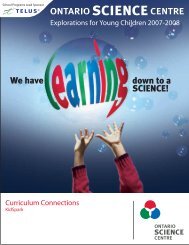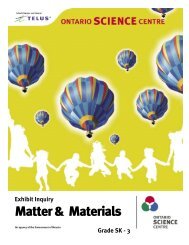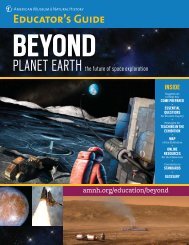Star Chart - Ontario Science Centre
Star Chart - Ontario Science Centre
Star Chart - Ontario Science Centre
Create successful ePaper yourself
Turn your PDF publications into a flip-book with our unique Google optimized e-Paper software.
EAST East<br />
NE<br />
SE<br />
Download our most recent star chart:<br />
www.ontariosciencecentre.ca/tour/default.asp?demoid=75<br />
NORTH North<br />
SOUTH South<br />
Cartography and design by Roberta Cooke. Base chart data derived from maps drawn by Roy Bishop for the Observer’s Handbook, published by The Royal Astronomical Society of Canada.<br />
ROTATING NIGHT SKY: During the night, the Earth’s rotation on its axis slowly<br />
shifts the entire sky. This is the same motion that swings the Sun on its daily eastto-west<br />
trek. The rotational hub is Polaris, the North <strong>Star</strong>, located almost exactly<br />
above the Earth’s North Pole. Everything majestically marches counter-clockwise<br />
around it, a motion that becomes evident after about half an hour.<br />
OUR CHART SHOWS the major stars, planets and constellations visible<br />
from Canada and the northern United States within one hour of these times:<br />
EARLY JULY: 11:30 P.M.; LATE JULY: 10:30 P.M.<br />
EARLY AUGUST: 9:30; LATE AUGUST: DUSK<br />
Prepared for the <strong>Ontario</strong> <strong>Science</strong> <strong>Centre</strong> by SkyNews,<br />
the Canadian Magazine of Astronomy & <strong>Star</strong>gazing. SkyNews.ca<br />
SkyNews.ca 1-866-759-0005<br />
NW<br />
SW<br />
WEST West<br />
TO USE THIS CHART: Hold the chart in front of you and rotate it so the direction<br />
you are facing (N,S,E,W) is at the bottom of the chart. The edge of the chart<br />
represents the horizon; the overhead point is at centre. On a moonless night in the<br />
country, you will see more stars than are shown here; deep in the city, you will see<br />
fewer. The ecliptic line is the celestial pathway of the Moon and planets. The star<br />
groups straddling this line are known as the zodiac constellations. The Moon is<br />
shown for selected dates.
S*T*A*R<br />
CHART<br />
FOR SUMMER<br />
July/August<br />
* 2012 *<br />
THE PLANETS<br />
VENUS has become a morning star!<br />
Following the rare Transit of Venus, you<br />
can now find the bright planet in the<br />
morning, just before sunset in the East.<br />
*<br />
MARS is located in the southwestern sky<br />
near Saturn and the star Spica. On Aug<br />
14/15 the trio will create a straight<br />
vertical line in the sky.<br />
*<br />
JUPITER is located in the constellation<br />
Taurus, creeping above the horizon in the<br />
west just before dawn. Jupiter, Venus, and<br />
the Moon will gather together in the sky<br />
on July 15.<br />
*<br />
SATURN is a brilliant ‘star’ in the south<br />
west, currently in Virgo, located near the<br />
star Spica.<br />
Check our calendar for more details:<br />
www.ontariosciencecentre.ca<br />
THE CONSTELLATIONS<br />
The star groups linked by lines are the constellations<br />
created by our ancestors thousands of years<br />
ago as a way of mapping the night sky. Modern<br />
astronomers still use the traditional names,<br />
which give today’s stargazers a permanent link to<br />
the sky myths and legends of the past. This<br />
season’s evening sky features Draco. The stars<br />
that make up the long body and tail of Draco the<br />
dragon weave between the Big and Little Dipper.<br />
Draco may represent the dragon Ladon, who<br />
protected the golden apples of the Hespiredes in<br />
Greek Mythology.<br />
OBSERVING HIGHLIGHTS<br />
JUL 3 Full Moon<br />
JUL 14 The crescent moon and the Pleiades star cluster<br />
line up<br />
JUL 24 The Moon, Spica, Saturn, and Spica hang<br />
together for a perfect photo op<br />
AUG 11 Perseid meteor shower peaks<br />
AUG 13 The daytime moon passes infront of the planet Venus,<br />
afternoon event in all of Canada<br />
AUG 21 Moon, Mars, and Spica group together in the sky.<br />
SPACE STATION SIGHTINGS<br />
As the space station orbits the Earth, sunlight reflects off<br />
of its giant solar arrays. From Earth, it appears as a bright<br />
object moving high across the night sky. Visit www.heavens-above.com<br />
to get a list of upcoming ISS passes over your community.<br />
MOON PHASES<br />
Full<br />
New<br />
JUL 3 (2:52 p.m. EDT)<br />
AUG 1 (11:27 p.m., EDT)<br />
JUL 19 (12:24 a.m. EDT)<br />
AUG 17 (11:54 a.m., EDT)<br />
*ASTRONOMY AT THE OSC*<br />
OBSERVING TIP:<br />
Need a night-sky friendly flashlight?<br />
Cover a flashlight's lamp with brown<br />
or red paper to dim its light and<br />
preserve your night vision.<br />
July 4 / August 1, 7:30 p.m.: Recreational Astronomy Night with the Royal Astronomical Society. The RASC members invite<br />
one and all to attend their free astronomy night. Each Recreational Astronomy Night features a speaker covering a wide<br />
range of astronomical and space science topics. Visit the website for more information: toronto.rasc.ca.<br />
August 6 – Curosity Lands NASA’s new rover, Curosity will land on Mars August 6th at 1:30am. In the days prior to the<br />
landing we will be presenting details of the mission. Stay tuned to our website for more details as they arise.<br />
August 12 – ‘One World, One Sky’ The <strong>Ontario</strong> <strong>Science</strong> <strong>Centre</strong> is holding its summer star party ‘One World, One Sky’ in partnership<br />
with Planet IndigenUS. The evening will feature activities and presentations reflecting the contributions of indigenous<br />
populations around the world to the arts and science of the night sky http://www.harbourfrontcentre.com/planetindigenus/.

















